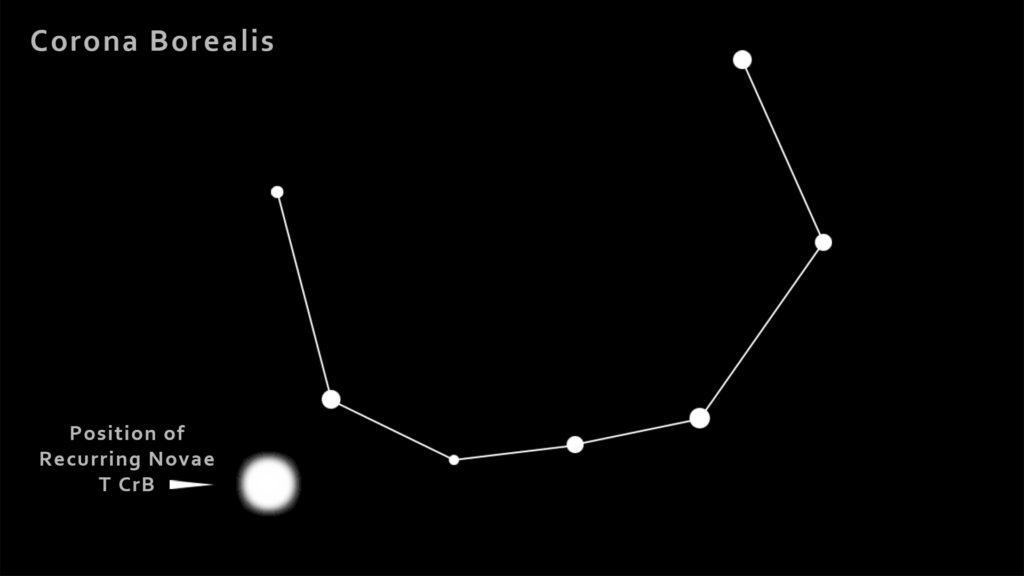The Recurring Novae T CrB in the astronomical sign Corona Borealis (The Northern Crown) has erupted several times before and will probably reappear in the start of 2024. It is not a Super Nova that explodes once and for all but a so-called Recurring Novae (RNe) that every almost 80 years lights up for several days. Last time it was observed was in 1866 and 1946 peaking at a visual magnitude of +2.0.
A visual magnitude of +2.0 is visible for the naked eye while the limit for the unaided eye is around +7.0. Venus at it´s brightest for example have a magnitude of around -4.0 which is much stronger than +2.0. Yes, the magnitude scale in astronomy is inverted.
According to Dr. Bradley E. Schaefer, Department of Physics and Astronomy, Louisiana State University, United States, T CrB outburst was probably also seen in the years 1217 and 1787.
In a catalog published 1789, Francis Wollaston, a British astronomer, reported an astrometric position for a star that is exactly on top of T CrB, that was reported at a visual magnitude at +7.8, which indicate that T CrB may have been in eruption at that time. At least something must have happened since it was at +7.8 which is brighter than the normal low-state at around +10.5
The 1217 event has an eyewitness report written by the monk Abbott Burchard of Upsberg as a fast rising stellar point-source in Corona Borealis that “shone with great light”, lasted for “many days”, and was described as being a “wonderful sign”.
Recurring Novae
The Recurring Novae (RNe) are defined as systems with more than one recorded Nova outburst. It is a group of cataclysmic variables that perform outbursts at intervals on the order of several decades. They are very rare with only 10 galactic RNe known to date. Novae are as far as we know all binary stars where the gainer is a white dwarf that attracts material from it´s “loser” companion. The loser can be a compact star, an M-type star (red dwarf star) that can be either a main sequence star like our own Sun, or one that is hydrogen poor, or a giant that is similar to the ones observed in symbiotic stars, which is binary systems where a white dwarf accretes from an evolved red giant.
A Nova is a runaway nuclear explosion on a very large scale that occurs on a white dwarf stars surface. When it reach a critical trigger threshold of supplied mass it explodes and ejects a shell of fast moving gas outwards. The explosion process makes the star much brighter than usual for several days. Subsequently it starts fading out to the normal visual magnitude at around 10,5 over a week or a month.
Will T CrB reappear in 2024?
Dr. Bradley E. Schaefer explains in this zoom conference video at 43:09 on Facebook when the next T CrB eruption likely will occur. It is based on graphs showing visual magnitude level distributed on a timescale. One graph shows the last two outbursts and the periods in between them. Another graph shows the possible time when we might be lucky to observe T CrB in eruption.
Just after new year 2024, in March-April-May probably, the Recurring Novae T CrB will reappear in the night sky. Before it erupts, it has a pre-eruption dip going from around +10.6 to around +11.75 and that dip falls in the start of 2024. The next thing that will happen is the eruption and an increase in brightness up to +2.0.
You can find the astronomical sign Corona Borealis in this sky map (Stellarium Online Star Map). Just type in Corona Borealis in the search field on top of the page and you´ll find it. When you have found the sign you can also look after T CrB itself if you zoom in on the area shown below in the illustration. Just look after a point with a “T”.

Illustration by BRJO

